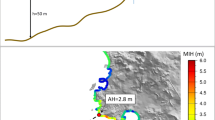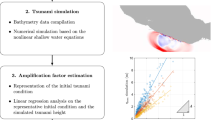Abstract
As with earthquakes, river floods, water waves, and wind intensities, a tsunami intensity has to be synthetic and comprehensive to be efficient. Tsunami impact is complex because the effects can be felt on the beach, on inundated areas and also at berths and anchors. Within the same local area, a tsunami may severely impact the population on the coast, while its effects may be negligible on marine bodies (boats). Most existing tsunami intensity scales are based either on water elevation or on induced currents. However, it is commonly admitted that both variables should be considered simultaneously. Several existing intensity scales were integrated and were made consistent with each other. An original intensity scale is then derived based on analysis of the interdependency between the maxima of tsunami amplitude and induced current: The dimension of the couple composed by two variables is analyzed, in particular through the derivation of a linear relationship using the long wave theory and the use of a fully nonlinear numerical experiment. Our intensity scale is particularly well adapted to numerical studies, for which the two variables are naturally derived within an entire computational grid. Once the tsunami intensity scale was set up, it was briefly applied to a particular case study: the impact of the Sumatra tsunami, dated December 26, 2004, on the coast of Sri Lanka. Indeed, the tsunami scales proposed herein represent an initial framework of study and can be further improved through new or revisited tsunami observations.





Similar content being viewed by others
References
Airy GB (1845) On tides and waves. Encylopaedia metropolitana 5 (mixed sciences), London, pp 241–396
Boschetti L, Ioualalen M, Nemati F, Grilli ST, Dessa J-X, Larroque C (2020) Tsunami intensity scale based on wave amplitude and current applied to the French Riviera. Nat Hazards 102(1):219–246. https://doi.org/10.1007/s11069-020-03921-0
Charvet I, Suppasri A, Imamura F (2014) Empirical fragility analysis of building damage caused by the 2011 Great East Japan tsunami in Ishinomaki city using ordinal regression, and influence of key geographical features. Stoch Environ Res Risk Assess 28:1853–1867. https://doi.org/10.1007/s00477-014-0850-2
Fenton JD (1985) Wave forces on vertical walls. J Wtrwy Port Coast Ocean Eng 111(4):693–718
Grilli ST, Ioualalen M, Asavanant J, Shi F, Kirby JT, Watts P (2007) Source constraints and model simulation of the December 26, 2004 Indian Ocean tsunami. J Wtrwy Port Coast Ocean Eng 133(6):414–428
Iida K, Cox DC, Pararas-Caragannis G (1967) Preliminary catalog of tsunamis occurring in the Pacific Ocean. Data Rep No 5, HIG 67-10, Hawaii Institute of Geophysics, University of Hawaii
Imamura A (1942) History of Japanese tsunamis. Kayo-No-Kagaku (Oceanography) 2:74–80 (in Japanese)
Imamura A (1949) List of tsunamis in Japan. J Seismol Soc Jpn 2:23–28
Ioualalen M, Asavanant J, Kaewbanjak N, Grilli ST, Kirby JT, Watts P (2007) Modeling of the 26th December 2004 Indian Ocean tsunami: case study of impact in Thailand. J Geophys Res Oceans 112:C07024. https://doi.org/10.1029/2006JC003850
Ioualalen M, Rentería W, Ilayaraja K, Chlieh M, Arreaga-Vargas P (2010) Case study of impact of the 26th December 2004 Indian Ocean Tsunami on the coast of Sri Lanka. Environ Model Softw 25(12):1874–1880
Ioualalen M, Pelletier B, Solis Gordillo G (2017) Investigating the March 28th 1875 and the September 20th 1920 earthquakes/tsunamis of the Southern Vanuatu arc, offshore Loyalty Islands, New Caledonia. Tectonophysics. https://doi.org/10.1016/j.tecto.2017.05.006
Liu PL-F, Lynett P, Fernando H, Jaffe BE, Fritz H, Higman B, Morton R, Goff J, Synolakis C (2005) Observations by the international tsunami survey team in Sri Lanka. Science 308(5728):1595. https://doi.org/10.1126/science.1110730
Lynett PJ, Borrero J, Son S, Wilson R, Miller K (2014) Assessment of the tsunami-induced current hazard. Geophys Res Lett 41:2048–2055. https://doi.org/10.1002/2013GL058680
Manche Y (1997) Propositions pour la prise en compte de la vulnérabilité dans la cartographie des risques naturels prévisibles. Revue de Géographie Alpine 85(2):49–62
Papadopoulos GA (2003) Quantification of tsunamis: a review. In: Yalçiner AC, Pelinovsky E, Okal E, Synolakis CE (eds) Submarine landslides and tsunamis, NATO science series (series IV: earth and environmental sciences), vol 21. Springer, Dordrecht. https://doi.org/10.1007/978-94-010-0205-9_30
Papadopoulos GA, Imamura F (2001) A proposal for a new tsunami intensity scale. Internat Tsunami symposium 2001 Proc, Seattle, Washington, 7–10 Aug 2001, pp 569–577
Papadopoulos GA, Caputo R, McAdoo B, Pavlides S, Karastathis V, Fokaefs A, Orfanogiannaka K, Valkaniotis S (2006) The large tsunami of 26 December 2004: field observations and eyewitnesses accounts from Sri Lanka, Maldives Is. and Thailand. Earth Planets Space 58:233–241
PPFR (1999) Plans de prévention des risques naturels (PPR): Risques d’inondation—Guide méthodologique. La documentation Française. ISBN: 2-11-004402-0
PPFR-Thau (2012) Plan de prévention des risques naturels d’inondation: Bassin versant de l’Etang de Thau, Commune de Villeveyrac. Direction Départementale des Territoires et de la Mer—Service Eau et Risques, Préfecture de l’Hérault
Shuto N (1993) Tsunami intensity and disasters. In: Tinti S (ed) Tsunamis in the world. Kluwer Academic Publishers, Dordrech, pp 197–216. https://doi.org/10.1007/978-94-017-3620-6_15
Suppasri A, Mas E, Charvet I, Gunasekera R, Imai K, Fukutani Y, Abe Y, Imamura F (2013a) Building damage characteristics based on surveyed data and fragility curves of the 2011 Great East Japan tsunami. Nat Hazards 66(2):319–341
Suppasri A, Charvet I, Imai K, Imamura F (2013b) Fragility curves based on data from the 2011 Great East Japan tsunami in Ishinomaki city with discussion of parameters influencing building damage. Earthq Spectra. https://doi.org/10.1193/053013EQS138
Wei G, Kirby JT (1995) A time-dependent numerical code for extended Boussinesq equations. J Wtrwy Port Coast Ocean Eng 121:251–261
Wei G, Kirby JT, Grilli ST, Subramanya R (1995) A fully nonlinear Boussinesq model for surface waves, part 1. Highly nonlinear unsteady waves. J Fluid Mech 294:71–92
Acknowledgements
The authors appreciated former comments of Prof. Gerassimos A. Papadopoulos and those of the anonymous referees who helped in improving the manuscript. We acknowledge support from the European Commission under the project “Assessment, Strategy and Risk Reduction for Tsunamis in Europe,” ASTARTE (Grant No. 603839).
Author information
Authors and Affiliations
Corresponding author
Additional information
Publisher's Note
Springer Nature remains neutral with regard to jurisdictional claims in published maps and institutional affiliations.
Rights and permissions
About this article
Cite this article
Boschetti, L., Ioualalen, M. Integrated tsunami intensity scale based on maxima of tsunami amplitude and induced current. Nat Hazards 105, 815–839 (2021). https://doi.org/10.1007/s11069-020-04338-5
Received:
Accepted:
Published:
Issue Date:
DOI: https://doi.org/10.1007/s11069-020-04338-5




